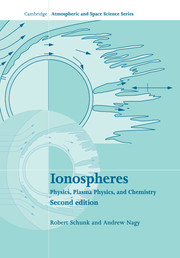Book contents
- Frontmatter
- Contents
- Chapter 1 Introduction
- Chapter 2 Space environment
- Chapter 3 Transport equations
- Chapter 4 Collisions
- Chapter 5 Simplified transport equations
- Chapter 6 Wave phenomena
- Chapter 7 Magnetohydrodynamic formulation
- Chapter 8 Chemical processes
- Chapter 9 Ionization and energy exchange processes
- Chapter 10 Neutral atmospheres
- Chapter 11 The terrestrial ionosphere at middle and low latitudes
- Chapter 12 The terrestrial ionosphere at high latitudes
- Chapter 13 Planetary ionospheres
- Chapter 14 Ionospheric measurement techniques
- Appendix A Physical constants and conversions
- Appendix B Vector relations and operators
- Appendix C Integrals and transformations
- Appendix D Functions and series expansions
- Appendix E Systems of units
- Appendix F Maxwell transfer equations
- Appendix G Collision models
- Appendix H Maxwell velocity distribution
- Appendix I Semilinear expressions for transport coefficients
- Appendix J Solar fluxes and relevant cross sections
- Appendix K Atmospheric models
- Appendix L Scalars, vectors, dyadics, and tensors
- Appendix M Radio wave spectrum
- Appendix N Simple derivation of continuity equation
- Appendix O Numerical solution for F region ionization
- Appendix P Monte Carlo methods
- Index
Chapter 3 - Transport equations
Published online by Cambridge University Press: 22 January 2010
- Frontmatter
- Contents
- Chapter 1 Introduction
- Chapter 2 Space environment
- Chapter 3 Transport equations
- Chapter 4 Collisions
- Chapter 5 Simplified transport equations
- Chapter 6 Wave phenomena
- Chapter 7 Magnetohydrodynamic formulation
- Chapter 8 Chemical processes
- Chapter 9 Ionization and energy exchange processes
- Chapter 10 Neutral atmospheres
- Chapter 11 The terrestrial ionosphere at middle and low latitudes
- Chapter 12 The terrestrial ionosphere at high latitudes
- Chapter 13 Planetary ionospheres
- Chapter 14 Ionospheric measurement techniques
- Appendix A Physical constants and conversions
- Appendix B Vector relations and operators
- Appendix C Integrals and transformations
- Appendix D Functions and series expansions
- Appendix E Systems of units
- Appendix F Maxwell transfer equations
- Appendix G Collision models
- Appendix H Maxwell velocity distribution
- Appendix I Semilinear expressions for transport coefficients
- Appendix J Solar fluxes and relevant cross sections
- Appendix K Atmospheric models
- Appendix L Scalars, vectors, dyadics, and tensors
- Appendix M Radio wave spectrum
- Appendix N Simple derivation of continuity equation
- Appendix O Numerical solution for F region ionization
- Appendix P Monte Carlo methods
- Index
Summary
A wide variety of plasma flows can be found in the various planetary ionospheres. For example, gentle near-equilibrium flows occur in the terrestrial ionosphere at mid-latitudes, while highly nonequilibrium flow conditions exist in the terrestrial polar wind and in the Venus ionosphere near the solar terminator. The highly nonequilibrium flows are generally characterized by large temperature differences between the interacting species, by flow speeds approaching and exceeding thermal speeds, and by flow conditions changing from collision-dominated to collisionless regimes. In an effort to model the various ionospheric flow conditions, several different mathematical approaches have been used, including collision-dominated and collisionless transport equations, kinetic and semikinetic models, and macroscopic particle-in-cell techniques. However, the transport equation approach has received the most attention, primarily because it can handle most of the flow conditions encountered in planetary ionospheres. Therefore, the main focus of this chapter is on transport theory, although other mathematical approaches are briefly discussed at the end of the chapter. Typically, numerous assumptions are made to simplify the transport equations before they are applied, and therefore, it is instructive to trace the derivation of the various sets of transport equations in order to establish their intrinsic strengths and limitations. Before diving into the rigorous derivation of the transport equations, it is useful to review the simple derivation of the continuity equation given in Appendix N.
Boltzmann equation
The Boltzmann equation is not only the starting point for the derivation of the different sets of transport equations but also forms the basis for the kinetic and semikinetic theories. With Boltzmann's approach, one is not interested in the motion of individual particles in the gas, but instead with the distribution of particles.
- Type
- Chapter
- Information
- IonospheresPhysics, Plasma Physics, and Chemistry, pp. 50 - 71Publisher: Cambridge University PressPrint publication year: 2009



